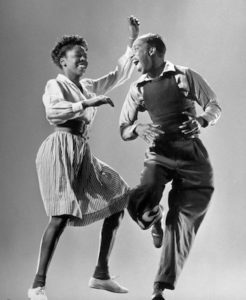
*On this date in 1927, the Lindy Hop dance was publicly introduced to the world. Lindy hop is an African American dance that was born in Harlem, New York City.
On that date, the Lindbergh Spirit of St. Louis airplane completed the first transatlantic flight by air; the Newspaper reported “Lindy Hops the Atlantic,” and the dance style adopted the headline. The dance has evolved since then with the jazz music of that time, and was very popular during the swing era of the late 1930s and early 1940s. Lindy was a fusion of many dances that preceded or were during its development, but is mainly based on jazz, tap, breakaway, and Charleston.
It is frequently described as a jazz dance and is a member of the swing dance family. In its development, the Lindy hop combined elements of partnered and solo dancing by using the movements and improvisation of African dances along with the formal eight-count structure of European partner dances, most clearly illustrated in Lindy's basic step, the swingout. In this step's open position, dancers are generally connected hand-to-hand; in its closed position, leads and follows are connected in an embrace on one side and holding hands on the other.
Lindy hop is sometimes called a street dance, referring to its improvisational and social nature. On March 27, 1932, twelve-year-old Norma Miller did the Lindy hop outside the Savoy Ballroom with her friends for tips. In 1935, 15,000 people danced on Bradhurst Avenue for the second time in a dance series held by the Parks Department. Between 147th and 148th street, Harlem "threw itself into the Lindy hop with abandon" as Sugar Hill residents watched from the bluffs along Edgecombe Avenue. There was renewed interest in the dance in the 1980s from American, Swedish, and British dancers, and Lindy hop is now represented by dancers and loosely affiliated grassroots organizations globally.